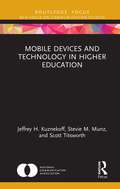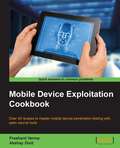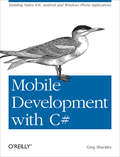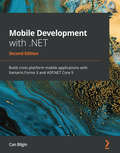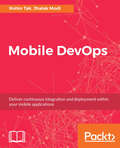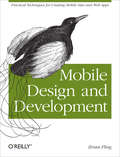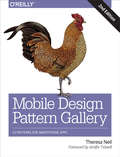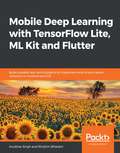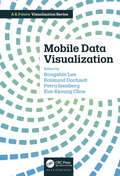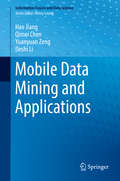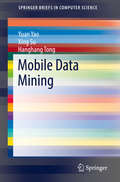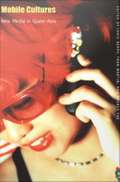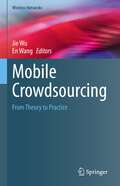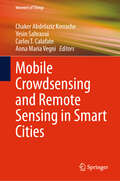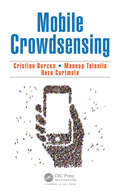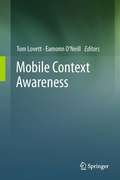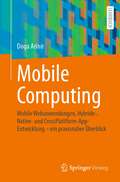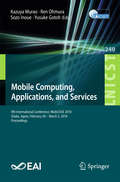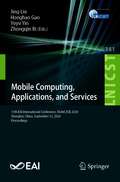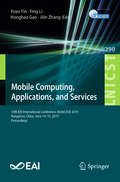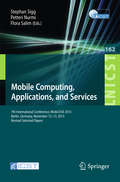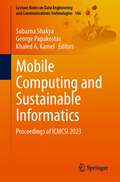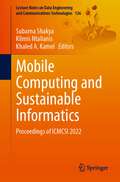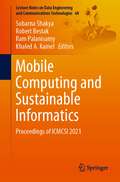- Table View
- List View
Mobile Devices and Technology in Higher Education: Considerations for Students, Teachers, and Administrators (NCA Focus on Communication Studies)
by Scott Titsworth Jeffrey H. Kuznekoff Stevie M. MunzThis book examines key issues at the intersection of education and technology by addressing the question that most educators face—how do we use technology to engage students in the learning process and enhance learning? Problematizing the view that technology is the default solution to a host of problems facing education, while also recognizing that technology has an important place in a variety of education levels, the book provides readers with clear insights on technology and learning from a variety of perspectives from communication studies, education, and related disciplines. This volume is an essential read for scholars and teachers working in the area of elementary education. It will also be of interest to academics working in the area of education, postsecondary education, and learning and can be used as an ancillary text in graduate-level seminars.
Mobile Device Exploitation Cookbook
by Akshay Dixit Prashant Kumar VermaThis book is intended for mobile security enthusiasts and penetration testers who wish to secure mobile devices to prevent attacks and discover vulnerabilities to protect devices.
Mobile Development with C#: Building Native iOS, Android, and Windows Phone Applications (Oreilly And Associate Ser.)
by Greg ShacklesIt’s true: you can build native apps for iOS, Android, and Windows Phone with C# and the .NET Framework—with help from MonoTouch and Mono for Android. This hands-on guide shows you how to reuse one codebase across all three platforms by combining the business logic layer of your C# app with separate, fully native UIs. It’s an ideal marriage of platform-specific development and the "write once, run everywhere" philosophy.By building a series of simple applications, you’ll experience the advantages of using .NET in mobile development and learn how to write complete apps that access the unique features of today’s three most important mobile platforms.Learn the building blocks for building applications on iOS, Android, and Windows PhoneDiscover how the Mono tools interact with iOS and AndroidUse several techniques and patterns for maximizing non-UI code reuseDetermine how much functionality can go into the shared business logic layerConnect to external resources with .NET’s rich networking stackRead and write data using each platform’s filesystem and local databaseCreate apps to explore the platforms’ location and mapping capabilities
Mobile Development with .NET: Build cross-platform mobile applications with Xamarin.Forms 5 and ASP.NET Core 5, 2nd Edition
by Can BilginA .NET developer's guide to leveraging .NET and C# skills for mobile development using Xamarin, Visual Studio 2019, and AzureKey FeaturesUncover the new features and capabilities of the .NET 5 framework in this updated and improved second editionOptimize the time required to develop highly performant cross-platform applicationsUnderstand the architectural patterns and best practices for mobile application developmentBook DescriptionThe .NET 5 framework is a unified framework with capabilities that enable you to use Microsoft's developer ecosystem on a single platform. Xamarin, used for developing mobile applications, is one of the app model implementations for .NET Core infrastructure. This book will show you how to design, architect, and develop attractive, maintainable, and robust mobile applications for multiple platforms, including iOS, Android, and UWP using Xamarin, .NET Core, and Azure. With the help of real-world scenarios, you'll explore different phases of application development using Xamarin, from environment setup, design, and architecture to publishing. Throughout the book, you'll learn how to develop mobile apps using Xamarin and .NET Standard. You'll even be able to implement a web-based backend composed of microservices with .NET Core using various Azure services including, but not limited to, Azure Active Directory, Azure Functions. As you advance, you'll create data stores using popular database technologies such as Cosmos DB and data models such as the relational model and NoSQL. By the end of this mobile application development book, you'll be able to create cross-platform mobile applications that can be deployed as cloud-based PaaS and SaaS.What you will learnDiscover the latest features of .NET 5 that can be used in mobile application developmentExplore Xamarin.Forms Shell for building cross-platform mobile UIsUnderstand the technical design requirements of a consumer mobile appGet to grips with advanced mobile development concepts such as app data management, push notifications, and graph APIsManage app data with Entity Framework CoreUse Microsoft's Project Rome for creating cross-device experiences with XamarinBecome well-versed with implementing machine learning in your mobile appsWho this book is forThis book is for ASP.NET Core developers who want to get started with mobile development using Xamarin and other Microsoft technologies. Working knowledge of C# programming is necessary to get started.
Mobile DevOps: Deliver continuous integration and deployment within your mobile applications
by Jhalak Modi Rohin TakThis step-by-step guide will teach you to continuously improve your mobile application development processKey Features●Efficiently deliver continuous integration and deployment within all the stages of your application's lifecycle●Learn to implement mobile DevOps with Xamarin and Visual Studio●Deliver high quality and performing mobile applicationsBook DescriptionToday's world is all about perfection, and there are hundreds of applications that are released each day out of which only a few succeed. Making sure that the app looks, performs, and behaves as expected is one of the biggest challenge developers face today.The main goal of this book is to teach developers to implement DevOps to build, test, and deliver. This book will teach you to implement Mobile DevOps at every stage of your application's lifecycle with Visual Studio and Xamarin Mobile Lifecycle solutions. Later, it will also show you how to leverage Mobile Center's continuous integration and automated testing to develop a high-quality applications. Next, you’ll see how to mobilize your on-premises data to the cloud and increase your productivity with code reuse. Finally, you’ll discover how to find and fix bugs beforehand, improving the efficiency of your application while it is being developed.By the end of this book, you will be well-versed with Mobile DevOps techniques, delivering high quality and high performance mobile apps.What you will learn●Become fluent with the basic components of Mobile Devops●Find out how to use code repositories and install Git on an EC2 server and manage users and groups●Set up an Android device for development and install Visual Studio and Xamarin on Windows●Create an Android project and UI for applications●Add permissions to Android Manifest●Write tests with Xamarin. UI and test using test cloud to check it on multiple devices●Monitor and optimize the application using the Android monitoring tool●Debug the mobile application and improve its efficiency Who this book is forIf you are a programmer and developer who wants to increase the efficiency and scalability of your mobile application with the implementation of DevOps, then this book is for you. You need basic experience of the application process development.
Mobile Design and Development: Practical concepts and techniques for creating mobile sites and web apps (Animal Guide)
by Brian FlingMobile devices outnumber desktop and laptop computers three to one worldwide, yet little information is available for designing and developing mobile applications. Mobile Design and Development fills that void with practical guidelines, standards, techniques, and best practices for building mobile products from start to finish. With this book, you'll learn basic design and development principles for all mobile devices and platforms. You'll also explore the more advanced capabilities of the mobile web, including markup, advanced styling techniques, and mobile Ajax. If you're a web designer, web developer, information architect, product manager, usability professional, content publisher, or an entrepreneur new to the mobile web, Mobile Design and Development provides you with the knowledge you need to work with this rapidly developing technology. Mobile Design and Development will help you:Understand how the mobile ecosystem works, how it differs from other mediums, and how to design products for the mobile contextLearn the pros and cons of building native applications sold through operators or app stores versus mobile websites or web appsWork with flows, prototypes, usability practices, and screen-size-independent visual designsUse and test cross-platform mobile web standards for older devices, as well as devices that may be available in the futureLearn how to justify a mobile product by building it on a budget
Mobile Design Pattern Gallery: UI Patterns for Smartphone Apps
by Theresa NeilWhen you’re under pressure to produce a well-designed, easy-to-navigate mobile app, there’s no time to reinvent the wheel—and no need to. This handy reference provides more than 90 mobile app design patterns, illustrated by 1,000 screenshots from current Android, iOS, and Windows Phone apps.Much has changed since this book’s first edition. Mobile OSes have become increasingly different, driving their own design conventions and patterns, and many designers have embraced mobile-centric thinking. In this edition, user experience professional Theresa Neil walks product managers, designers, and developers through design patterns in 11 categories:Navigation: get patterns for primary and secondary navigationForms: break industry-wide habits of bad form designTables: display only the most important informationSearch, sort, and filter: make these functions easy to useTools: create the illusion of direct interactionCharts: learn best practices for basic chart designTutorials & Invitations: invite users to get started and discover featuresSocial: help users connect and become part of the groupFeedback & Affordance: provide users with timely feedbackHelp: integrate help pages into a smaller form factorAnti-Patterns: what not to do when designing a mobile app
Mobile Deep Learning with TensorFlow Lite, ML Kit and Flutter: Build scalable real-world projects to implement end-to-end neural networks on Android and iOS
by Anubhav Singh Rimjhim BhadaniLearn how to deploy effective deep learning solutions on cross-platform applications built using TensorFlow Lite, ML Kit, and Flutter Key Features Work through projects covering mobile vision, style transfer, speech processing, and multimedia processing Cover interesting deep learning solutions for mobile Build your confidence in training models, performance tuning, memory optimization, and neural network deployment through every project Book Description Deep learning is rapidly becoming the most popular topic in the mobile app industry. This book introduces trending deep learning concepts and their use cases with an industrial and application-focused approach. You will cover a range of projects covering tasks such as mobile vision, facial recognition, smart artificial intelligence assistant, augmented reality, and more. With the help of eight projects, you will learn how to integrate deep learning processes into mobile platforms, iOS, and Android. This will help you to transform deep learning features into robust mobile apps efficiently. You'll get hands-on experience of selecting the right deep learning architectures and optimizing mobile deep learning models while following an application oriented-approach to deep learning on native mobile apps. We will later cover various pre-trained and custom-built deep learning model-based APIs such as machine learning (ML) Kit through Firebase. Further on, the book will take you through examples of creating custom deep learning models with TensorFlow Lite. Each project will demonstrate how to integrate deep learning libraries into your mobile apps, right from preparing the model through to deployment. By the end of this book, you'll have mastered the skills to build and deploy deep learning mobile applications on both iOS and Android. What you will learn Create your own customized chatbot by extending the functionality of Google Assistant Improve learning accuracy with the help of features available on mobile devices Perform visual recognition tasks using image processing Use augmented reality to generate captions for a camera feed Authenticate users and create a mechanism to identify rare and suspicious user interactions Develop a chess engine based on deep reinforcement learning Explore the concepts and methods involved in rolling out production-ready deep learning iOS and Android applications Who this book is for This book is for data scientists, deep learning and computer vision engineers, and natural language processing (NLP) engineers who want to build smart mobile apps using deep learning methods. You will also find this book useful if you want to improve your mobile app's user interface (UI) by harnessing the potential of deep learning. Basic knowledge of neural networks and coding experience in Python will be beneficial to get started with this book.
Mobile Data Visualization (AK Peters Visualization Series)
by Bongshin LeeMobile Data Visualization is about facilitating access to and understanding of data on mobile devices. Wearable trackers, mobile phones, and tablets are used by millions of people each day to read weather maps, financial charts, or personal health meters. What is required to create effective visualizations for mobile devices? This book introduces key concepts of mobile data visualization and discusses opportunities and challenges from both research and practical perspectives. Mobile Data Visualization is the first book to provide an overview of how to effectively visualize, analyze, and communicate data on mobile devices. Drawing from the expertise, research, and experience of an international range of academics and practitioners from across the domains of Visualization, Human Computer Interaction, and Ubiquitous Computing, the book explores the challenges of mobile visualization and explains how it differs from traditional data visualization. It highlights opportunities for reaching new audiences with engaging, interactive, and compelling mobile content. In nine chapters, this book presents interesting perspectives on mobile data visualization including: how to characterize and classify mobile visualizations; how to interact with them while on the go and with limited attention spans; how to adapt them to various mobile contexts; specific methods on how to design and evaluate them; reflections on privacy, ethical and other challenges, as well as an outlook to a future of ubiquitous visualization. This accessible book is a valuable and rich resource for visualization designers, practitioners, researchers, and students alike.
Mobile Data Mining and Applications (Information Fusion and Data Science)
by Hao Jiang Qimei Chen Yuanyuan Zeng Deshi LiThis book focuses on mobile data and its applications in the wireless networks of the future. Several topics form the basis of discussion, from a mobile data mining platform for collecting mobile data, to mobile data processing, and mobile feature discovery. Usage of mobile data mining is addressed in the context of three applications: wireless communication optimization, applications of mobile data mining on the cellular networks of the future, and how mobile data shapes future cities. In the discussion of wireless communication optimization, both licensed and unlicensed spectra are exploited. Advanced topics include mobile offloading, resource sharing, user association, network selection and network coexistence. Mathematical tools, such as traditional convexappl/non-convex, stochastic processing and game theory are used to find objective solutions. Discussion of the applications of mobile data mining to cellular networks of the future includes topics such as green communication networks, 5G networks, and studies of the problems of cell zooming, power control, sleep/wake, and energy saving. The discussion of mobile data mining in the context of smart cities of the future covers applications in urban planning and environmental monitoring: the technologies of deep learning, neural networks, complex networks, and network embedded data mining. Mobile Data Mining and Applications will be of interest to wireless operators, companies, governments as well as interested end users.
Mobile Data Mining (SpringerBriefs in Computer Science)
by Yuan Yao Xing Su Hanghang TongThis SpringerBrief presents a typical life-cycle of mobile data mining applications, including:data capturing and processing which determines what data to collect, how to collect these data, and how to reduce the noise in the data based on smartphone sensors feature engineering which extracts and selects features to serve as the input of algorithms based on the collected and processed data model and algorithm designIn particular, this brief concentrates on the model and algorithm design aspect, and explains three challenging requirements of mobile data mining applications: energy-saving, personalization, and real-time Energy saving is a fundamental requirement of mobile applications, due to the limited battery capacity of smartphones. The authors explore the existing practices in the methodology level (e.g. by designing hierarchical models) for saving energy. Another fundamental requirement of mobile applications is personalization. Most of the existing methods tend to train generic models for all users, but the authors provide existing personalized treatments for mobile applications, as the behaviors may differ greatly from one user to another in many mobile applications. The third requirement is real-time. That is, the mobile application should return responses in a real-time manner, meanwhile balancing effectiveness and efficiency. This SpringerBrief targets data mining and machine learning researchers and practitioners working in these related fields. Advanced level students studying computer science and electrical engineering will also find this brief useful as a study guide.
Mobile Cultures: New Media in Queer Asia
by Chris Berry Audrey Yue Fran MartinMobile Cultures provides much-needed, empirically grounded studies of the connections between new media technologies, the globalization of sexual cultures, and the rise of queer Asia. The availability and use of new media--fax machines, mobile phones, the Internet, electronic message boards, pagers, and global television--have grown exponentially in Asia over the past decade. This explosion of information technology has sparked a revolution, transforming lives and lifestyles, enabling the creation of communities and the expression of sexual identities in a region notorious for the regulation of both information and sexual conduct. Whether looking at the hanging of toy cartoon characters like "Hello Kitty" from mobile phones to signify queer identity in Japan or at the development of queer identities in Indonesia or Singapore, the essays collected here emphasize the enormous variance in the appeal and uses of new media from one locale to another. Scholars, artists, and activists from a range of countries, the contributors chronicle the different ways new media galvanize Asian queer communities in Taiwan, South Korea, Japan, Indonesia, Thailand, Malaysia, India, and around the world. They consider phenomena such as the uses of the Internet among gay, lesbian, or queer individuals in Taiwan and South Korea; the international popularization of Japanese queer pop culture products such as Yaoi manga; and a Thai website's reading of a scientific tract on gay genetics in light of Buddhist beliefs. Essays also explore the politically subversive possibilities opened up by the proliferation of media technologies, examining, for instance, the use of Cyberjaya--Malaysia's government-backed online portal--to form online communities in the face of strict antigay laws. Contributors. Chris Berry, Tom Boellstorff, Larissa Hjorth, Katrien Jacobs, Olivia Khoo, Fran Martin, Mark McLelland, David Mullaly, Baden Offord, Sandip Roy, Veruska Sabucco, Audrey Yue
Mobile Crowdsourcing: From Theory to Practice (Wireless Networks)
by Jie Wu En WangThis book offers the latest research results in recent development on the principles, techniques and applications in mobile crowdsourcing. It presents state-of-the-art content and provides an in-depth overview of the basic background in this related field. Crowdsourcing involves a large crowd of participants working together to contribute or produce goods and services for the society. The early 21st century applications of crowdsourcing can be called crowdsourcing 1.0, which includes businesses using crowdsourcing to accomplish various tasks, such as the ability to offload peak demand, access cheap labor, generate better results in a timely matter, and reach a wider array of talent outside the organization. Mobile crowdsensing can be described as an extension of crowdsourcing to the mobile network to combine the idea of crowdsourcing with the sensing capacity of mobile devices. As a promising paradigm for completing complex sensing and computation tasks, mobile crowdsensing serves the vital purpose of exploiting the ubiquitous smart devices carried by mobile users to make conscious or unconscious collaboration through mobile networks. Considering that we are in the era of mobile internet, mobile crowdsensing is developing rapidly and has great advantages in deployment and maintenance, sensing range and granularity, reusability, and other aspects. Due to the benefits of using mobile crowdsensing, many emergent applications are now available for individuals, business enterprises, and governments. In addition, many new techniques have been developed and are being adopted. This book will be of value to researchers and students targeting this topic as a reference book. Practitioners, government officials, business organizations and even customers -- working, participating or those interested in fields related to crowdsourcing will also want to purchase this book.
Mobile Crowdsensing and Remote Sensing in Smart Cities (Internet of Things)
by Anna Maria Vegni Carlos T. Calafate Chaker Abdelaziz Kerrache Yesin SahraouiThis book focuses on the benefits of mobile crowdsensing (MCS) and remote sensing applications in smart cities, particularly in creating an intelligent context-aware environment, especially in cases of infectious diseases that cause widespread loss of life. The authors first introduce the concepts of MCS and remote sensing in smart cities. The authors go on to discuss topics such as power of mobile edge and cloud computing for data analytics; strategies to effectively manage and mitigate data redundancy; crowd management during the Covid-19 pandemic; techniques to detect communities in complex data through social sensing; and much more. The authors also aim to show that the efficient implementation of MCS and remote sensing in various applications comes with several challenging issues that need to be addressed, including data quality and reliability, security and privacy, and ethical considerations. Focuses on the benefits of mobile crowdsensing (MCS) and remote sensing applications in smart cities; Covers technical details of remote sensing starting from the communication support to the application; Includes overcoming challenges including data quality and reliability, security and privacy, and ethical considerations.
Mobile Crowdsensing
by Cristian Borcea Manoop Talasila Reza CurtmolaMobile crowdsensing is a technology that allows large scale, cost-effective sensing of the physical world. In mobile crowdsensing, mobile personal devices such as smart phones or smart watches come equipped with a variety of sensors that can be leveraged to collect data related to environment, transportation, healthcare, safety and so on. This book presents the first extensive coverage of mobile crowdsensing, with examples and insights drawn from the authors’ extensive research on this topic as well as from the research and development of a growing community of researchers and practitioners working in this emerging field. Throughout the text, the authors provide the reader with various examples of crowdsensing applications and the building blocks to creating the necessary infrastructure, explore the related concepts of mobile sensing and crowdsourcing, and examine security and privacy issues introduced by mobile crowdsensing platforms. Provides a comprehensive description of mobile crowdsensing, a one-stop shop for all relevant issues pertaining to mobile crowdsensing, including motivation, applications, design and implementation, incentive mechanisms, and reliability and privacy. Describes the design and implementations of mobile crowdsensing platforms of great interest for the readers working in research and industry to quickly implement and test their systems. Identifies potential issues in building such mobile crowdsensing applications to ensure their usability in real life and presents future directions in mobile crowdsensing by emphasizing the open problems that have to be addressed.
Mobile Context Awareness
by Tom Lovett Eamonn O'NeillMobile context-awareness is a popular research trend in the field of ubiquitous computing. Advances in mobile device sensory hardware and the rise of 'virtual' sensors such as web application programming interfaces (APIs) mean that the mobile user is exposed to a vast range of data that can be used for new advanced applications. Mobile Context Awareness presents work from industrial and academic researchers, focusing on novel methods of context acquisition in the mobile environment - particularly through the use of physical and virtual sensors - along with research into new applications utilising this context. In addition, the book provides insights into the technical and usability challenges involved in mobile context-awareness, as well as observations on current and future trends in the field.
Mobile Computing: Mobile Webanwendungen, Hybride-, Native- und CrossPlattform-AppEntwicklung – ein praxisnaher Überblick
by Doga ArinirÜber den Apple Store kann man zurzeit Millionen mobiler Anwendungen herunterladen. Die Einsatzmöglichkeiten sind vielfältig und die Bandbreite der Anwendungsszenarien bewegt sich von komplexen Computerspielen bis hin zu Geschäftsanwendungen. In den vergangenen Jahren wurden unterschiedliche Entwicklungsparadigmen bereitgestellt, die hinsichtlich verschiedener Aspekte wie zum Beispiel Plattformunabhängigkeit, Performanz, Kosten sowie dem Zugriff auf gerätespezifische, native Funktionen sowohl Vor- als auch Nachteile besitzen. Die Kapitel gehen didaktisch in die Breite und stellen die Entwicklungsparadigmen vor dem Hintergrund einer zentralen Fallstudie gegenüber. Es werden Techniken zur Entwicklung von mobilen Webanwendungen, hybriden Anwendungen, nativen Anwendungen für Android sowie Cross-Plattform-Anwendungen vorgestellt, ohne innerhalb eines Paradigmas zu sehr in die Tiefe zu gehen. Eine Ausnahme bildet das von Google bereitgestellte Flutter-Framework, das sowohl die Entwicklung auf Android- als auch iOS-Geräten unterstützt.Dieses Lehrbuch richtet sich an Studentinnen und Studenten, die bereits mit einer objektorientierten Programmiersprache vertraut sind und wesentliche Aspekte der Programmierung kennen und einen Einblick in das Mobile Computing erlangen möchten.
Mobile Computing, Applications, and Services: 9th International Conference, Mobicase 2018, Osaka, Japan, February 28 - March 2, 2018, Proceedings (Lecture Notes of the Institute for Computer Sciences, Social Informatics and Telecommunications Engineering #240)
by Sozo Inoue Kazuya Murao Ren Ohmura Yusuke GotohThis book constitutes the thoroughly refereed post-conference proceedings of the 9th International Conference on Mobile Computing, Applications, and Services (MobiCASE 2015) held in Osaka, Japan, February 28 – March 2, 2018. The 10 full papers and 13 demo/ poster papers were carefully reviewed and selected from 35 submissions. The conference papers are covering intelligent caching; activity recognition and crowdsourcing; mobile frameworks; middleware; interactive applications; and mobility.
Mobile Computing, Applications, and Services: 12th EAI International Conference, MobiCASE 2021, Virtual Event, November 13–14, 2021, Proceedings (Lecture Notes of the Institute for Computer Sciences, Social Informatics and Telecommunications Engineering #434)
by Albert Zomaya Ning Li Shuiguang DengThis book constitutes the thoroughly refereed post-conference proceedings of the 12th International Conference on Mobile Computing, Applications, and Services, MobiCASE 2021, held in November 2021. Due to COVID-19 pandemic the conference was held virtually. The 9 full papers were carefully reviewed and selected from 21 submissions. The papers are organized in two topical tracks: mobile application and deep learning, and mobile application with data analysis.
Mobile Computing, Applications, and Services: 11th EAI International Conference, MobiCASE 2020, Shanghai, China, September 12, 2020, Proceedings (Lecture Notes of the Institute for Computer Sciences, Social Informatics and Telecommunications Engineering #341)
by Jing Liu Honghao Gao Yuyu Yin Zhongqin BiThis book constitutes the thoroughly refereed post-conference proceedings of the 11th International Conference on Mobile Computing, Applications, and Services, MobiCASE 2020, held in Shanghai, China, in September 2020. The conference was held virtually due to the COVID-19 pandemic.The 15 full papers were carefully reviewed and selected from 49 submissions. The papers are organized in topical sections on mobile application and framework; mobile application with data analysis; and AI application.
Mobile Computing, Applications, and Services: 10th EAI International Conference, MobiCASE 2019, Hangzhou, China, June 14–15, 2019, Proceedings (Lecture Notes of the Institute for Computer Sciences, Social Informatics and Telecommunications Engineering #290)
by Ying Li Honghao Gao Yuyu Yin Jilin ZhangThis book constitutes the thoroughly refereed post-conference proceedings of the 10th International Conference on Mobile Computing, Applications, and Services, MobiCASE 2019, held in Hangzhou, China, in June 2019. The 17 full papers were carefully reviewed and selected from 48 submissions. The papers are organized in topical sections on mobile application with data analysis, mobile application with AI, edge computing, energy optimization and application
Mobile Computing, Applications, and Services
by Stephan Sigg Petteri Nurmi Flora SalimThis book constitutes the proceedings of the 7thInternational Conference on Mobile Computing, Applications, and Services(MobiCASE 2015) held in Berlin, Germany, in November 2015. The 16 full and 4poster papers were carefully reviewed and selected from 43 submissions, and arepresented together with 4 papers from the First Workshop on SituationRecognition by Mining Temporal Information (SIREMETI 2015). The conferencepapers cover the following topics: intelligent caching, activity recognitionand crowdsourcing, mobile frameworks, middleware, interactive applications andmobility.
Mobile Computing and Sustainable Informatics: Proceedings of ICMCSI 2023 (Lecture Notes on Data Engineering and Communications Technologies #166)
by Subarna Shakya Khaled A. Kamel George PapakostasThis book gathers selected high-quality research papers presented at International Conference on Mobile Computing and Sustainable Informatics (ICMCSI 2022) organized by Pulchowk Campus, Institute of Engineering, Tribhuvan University, Nepal, during January 11–12, 2023. The book discusses recent developments in mobile communication technologies ranging from mobile edge computing devices to personalized, embedded, and sustainable applications. The book covers vital topics like mobile networks, computing models, algorithms, sustainable models, and advanced informatics that support the symbiosis of mobile computing and sustainable informatics.
Mobile Computing and Sustainable Informatics: Proceedings of ICMCSI 2022 (Lecture Notes on Data Engineering and Communications Technologies #126)
by Klimis Ntalianis Subarna Shakya Khaled A. KamelThis book gathers selected high-quality research papers presented at International Conference on Mobile Computing and Sustainable Informatics (ICMCSI 2022) organized by Pulchowk Campus, Institute of Engineering, Tribhuvan University, Nepal, during 27–28 January 2022. The book discusses recent developments in mobile communication technologies ranging from mobile edge computing devices, to personalized, embedded and sustainable applications. The book covers vital topics like mobile networks, computing models, algorithms, sustainable models and advanced informatics that supports the symbiosis of mobile computing and sustainable informatics.
Mobile Computing and Sustainable Informatics: Proceedings of ICMCSI 2021 (Lecture Notes on Data Engineering and Communications Technologies #68)
by Robert Bestak Subarna Shakya Ram Palanisamy Khaled A. KamelThis book gathers selected high-quality research papers presented at International Conference on Mobile Computing and Sustainable Informatics (ICMCSI 2021) organized by Pulchowk Campus, Institute of Engineering, Tribhuvan University, Nepal, during 29–30 January 2021. The book discusses recent developments in mobile communication technologies ranging from mobile edge computing devices, to personalized, embedded and sustainable applications. The book covers vital topics like mobile networks, computing models, algorithms, sustainable models and advanced informatics that supports the symbiosis of mobile computing and sustainable informatics.
